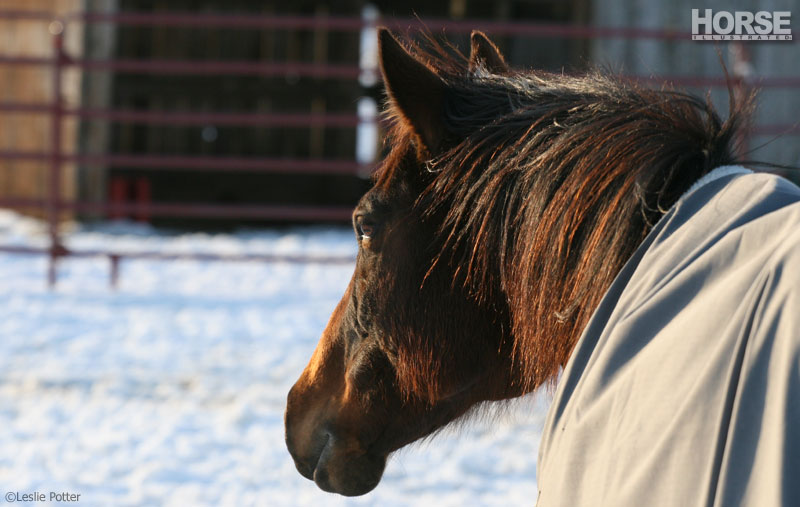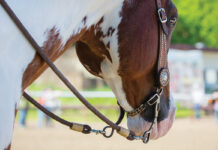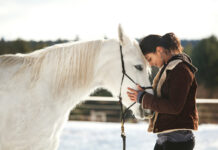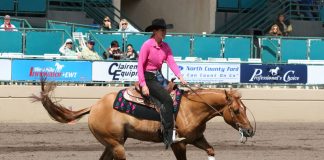Don’t let bad weather derail your training. By following my two rules for conditioning during downtime (outlined below), you will not only ease your horse’s re-entry to full-time riding, you will avoid the plateaus and training setbacks that plague students in wintery climates.

Recent data from biomechanics researchers and veterinary schools show that large inconsistencies in fitness can be detrimental to overall health, particularly for older horses. Most notably, periods of lesser activity lasting over a month can weaken deep postural muscles and supporting soft tissue. When a horse is once again placed in a workout routine, he is more likely to use compensatory postures and muscles, leading to lackluster performance or injury.
A period of decreased activity, such as a winter cold snap, can be an ideal time to improve the deep postural muscles of your horse that are responsible for stabilizing and supporting gymnastic activities. Used effectively, they can yield productive outcomes.
Rule One: Prioritize Calisthenics
When your horse isn’t accessing his patterned body habits through his regular workout routines, his nervous system can adapt to new habits. If he has patterns to unlearn, such as crookedness, hollowness, or side-dominance, this is the best time to make permanent changes. Think of these periods as rewiring his nervous system through slow, methodical recruitment of the muscle groups that support and refine locomotion rather than the ones that create big motions.
By committing to a brief but consistent daily schedule of calisthenics, you can optimize the horse’s deep muscles that positively influence proprioception and stabilize his spine and pelvis. In just 20 minutes per day, at least four times per week, you can achieve worthwhile results. In fact, research at Michigan State University demonstrated that by performing dynamic mobilization exercises every day, laid off horses were able to maintain nearly 80 percent of the tone in their spinal stabilizing muscles compared to horses in full riding training. Begin your 20- minute calisthenics session with the following maneuvers.
While keeping your horse’s feet immobile, use a treat to entice his head/neck to the following positions:
- Middle of his chest (chin to chest)
- Between the knees
- Between the front fetlocks
- The girth
- Flank hip (holding treat about two feet outward from flank)
- Towards hind fetlock
Once you have completed these maneuvers (in both directions, where relevant), ask your horse to walk backwards 30 steps, which will activate his abdominal muscles and hamstrings while mobilizing his lumbar spine. Then walk him back and forth over a row of five to eight ground poles (spaced roughly two and a half feet apart and raised off the ground 6 inches) a total of 25 times. When done consistently, this simple mini routine will pay big rewards for your horse. You will not only maintain tone in his postural muscles but, in the case of poor body habits, be able to create new neural pathways and muscle memories.
Sufficient movement is necessary for immunity, flexibility, and overall health. Circulating blood, oxygen, and gas molecules around the body helps flush toxins and inflammation that otherwise collect in joints. Don’t rely on pasture turnout alone to provide your horse the sustained daily movement he needs—most horses move around in turnout less than we think, and in most cases this movement is erratic rather than continuous. If you’re not riding much this winter, there are plenty of other ways to bring more motion to your horse’s day.
Rule Two: Prioritize Movement
The simplest and arguably best way to add movement to your horse’s day is to take him for a brisk walk. In an active walk, the back pulsates and swings, helping to remove tension and muscle bunching. Walking your horse daily—in-hand, ponying, ground driving, hot walker, longe line—for 15 to 30 minutes uninterrupted will ensure his circulatory system stays tuned up. That means his winter layoff will not be afflicted with stiffness, inflammation, or poor blood supply.
Absent the rigors and structures of normal training routines, get creative with bringing movement to your horse’s day. Set up obstacles to wander around. Play with a soccer ball. Teach him groundwork exercises. At our farm, I like to leave a box set up on the ground formed by four poles ad then we can use it in all kinds of ways to walk, sidepass, circle around, walk cloverleaves in and out of the box, and so on. Nearby is a gently sloped driveway where we ask the horses to walk up backwards. The formality or type of movement doesn’t matter; what counts is just that he moves. Think of sustained movement as flushing his whole operating system.
Re-entering a full-time routine should be seamless after a downtime focused on calisthenics and postural recruitment. Meanwhile, the horse’s circulation, digestion, and muscle function should be well primed after ensuring he has received easy but sustained daily movement during his layoff. By following my simple rules above, your training will continue to move forward from season to season even with interruptions to your routine.
Liked this article? Here are others you’ll enjoy:
Try This: Riding over Raised Poles
Cure Winter Boredom with Barn Aisle Exercises
Improve Your Horse’s Fitness with Trot-to-Canter Transitions






cool
Excellent!
I liked your article and I am posting it at our barn for other riders to read and implement. I am a strong believer of trying to keep my horses fit through the winter so I’m ready for spring trail riding.
Thank you. Really enjoyed and so will my horse with the added plan for keeping him fit with a wonderful routine to have available for baseline conditioning. Thank you. Plan to share with many of my equine friends.